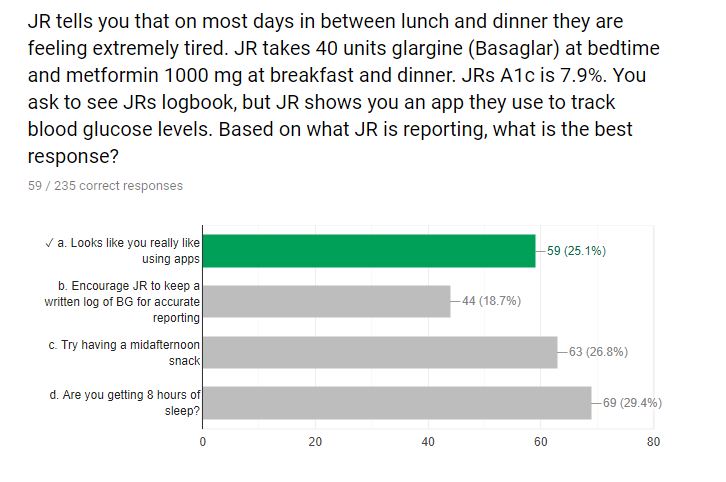For Question of the week, test takers usually choose the correct answer 70-80% of the time. However, for this Tuesday’s question of the week, only 25% of respondents chose the correct answer.
We thought this presented a perfect opportunity to explore this question and the best answer in more detail and throw in some test-taking tips along the way.
Question of week on October 1:

As shown above, the most common choice was option 4, the second most common answer was option 3, then option 1, and finally option 2.
Test taking strategies:
A good strategy for the exam for questions that give multiple distracting facts at once, is to read through each answer carefully and use process of elimination. First, get rid of one to two false answers that are either wrong or don’t address the main intent of the question. This leaves two answers and a 50% chance of choosing the BEST answer.
The key sentence here is “You ask to see JRs logbook, but JR shows you an app they use to track blood glucose levels.” Then there is a prompt to give a response.
Option 4 is a “juicy” answer because the first sentence shows JR admitting they’re tired. But the answer does not address the main intent of the question. Another distraction in the question includes that that they’re specifically feeling tired between lunch and dinner.
Option 4 also ignores the fact the educator asked to see their logbook and they respond by showing an app. Option 4 gets the test taker off-topic from the core question.
Also off-topic is Option 3. The test question vignette includes another distraction when it highlights that JR is specifically feeling tired between lunch and dinner. It would be easy to assume they are tired because of low blood sugar, which a midafternoon snack could fix, but there is no data to support that JR is having hypoglycemia. When reading the entire question, the core issue is that the educator asked to see a logbook but are shown an app instead.
Option 2 nods to the key intent of the question, but the educator fails to acknowledge that JR is trying to use an app to track blood glucose levels and other self-care behaviors. Instead, the educator ignores the app usage and instructs JR to keep a written log. This does not convey a person-centered approach, but instead asks JR to track blood glucose in a way that is familiar to the educator.
Option 1 is the person-centered option that acknowledges the individual and their preference for tracking their diabetes data using technology. “Looks like you really like using apps.” At that point in an appointment, the educator can use a curiosity based approach, “Can I please see the data you are collecting on your app? Have you noticed any trends or incidence of hypoglycemia in the afternoon?”
Together, JR and the educator might even explore other apps that might be useful and support JR in living with diabetes).
Language & Diabetes is a great, free resource to gain more insight into why Option 1 is the best answer to this question. Thank you so much for taking the time to answer our Question of the Week and participate in this fun learning activity!
Sign up for Diabetes Blog Bytes – we post one daily Blog Byte from Monday to Friday. And of course, Tuesday is our Question of the Week. It’s Informative and FREE! Sign up below!
[yikes-mailchimp form=”1″]








